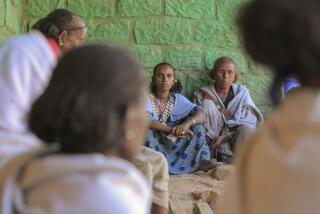Army Collapse Reportedly Cripples Ethiopian Regime
- Share via
ADDIS ABABA, Ethiopia — The Ethiopian army, the largest fighting force in sub-Saharan Africa, has collapsed in chaos, crippling the 12-year-old Marxist regime of President Mengistu Haile Mariam, local and Western specialists here say.
In the last four weeks, the 300,000-member army has been battered by a much smaller force of rebels from the Tigre People’s Liberation Front, one of two major guerrilla bands operating in the north of the country.
The Tigre Front has swept to within 150 miles of the capital, Addis Ababa, threatening a main supply road linking the capital to the Red Sea port of Assab.
In the process, the front has torn apart some of the army’s best-trained units as well as regiments of untrained boys dragooned into the service in a brutal conscription drive last April.
The military reversals come at a time when the Mengistu regime faces its most serious political and economic crisis since the famine of 1984-85. Public disaffection with the inept government is higher than at any time since top military officers attempted a coup in May, and diplomats here say there has been at least one attempt on the president’s life in the last month.
The Soviet government, since 1974 Mengistu’s main supplier of military aid and materiel, has told the government that it may not renew the arms supply agreement that is scheduled to expire in 1991. Although the Soviets are not thought likely to abandon Africa’s only Leninist regime, in which they have invested as much as $10 billion in military aid over the past decade or so, they are known to have urged Mengistu to settle the northern wars.
Meanwhile, crops have failed again in northern Ethiopia, meaning that as many as 1.7 million people will face starvation without substantial food aid from Western donors. And this summer’s collapse of the worldwide price of coffee, Ethiopia’s main export, has cut foreign exchange earnings by as much as 40%.
“There really are a lot of signs that the Mengistu regime is coming apart at the seams,” a Western diplomatic source in Addis Ababa said recently. “It’s not just the usual crisis.”
The deterioration of the army is a key development because the military is the strongest--some might say the only--base of support for the regime. It was the army that deposed the aged Emperor Haile Selassie in 1974 in Africa’s only avowedly Marxist-Leninist revolution.
The government was taken over by a secretive military body known as the Dergue, or committee. Mengistu emerged as the most influential member of this group in 1975 and consolidated his rule after a 1977 shoot-out at Dergue headquarters that took the lives of six other members.
There is little support now for the personally uninspiring Mengistu in other traditional power centers in the country, and virtually no taste for the government’s discredited Marxist ideology, according to observers here.
The peasantry, which accounts for 90% of the population, is increasingly unhappy with a restrictive and impoverishing agricultural policy that has reduced grain production by more than 20% in the last 10 years.
The tiny group of small businessmen and traders is passive, and the bureaucracy--one of the best-trained, technically adept and reform-minded in Africa--is frustrated by the need to await policy decisions from the secretive Dergue.
As for the army, at least one East Bloc source in Addis Ababa estimated that it has lost as many as 60,000 men--killed, wounded or deserted--in fighting the Tigre Front since January. That is more than the nearly 50,000 men the United States lost in the Vietnam War.
The army’s defeats came from an unexpected quarter. The Tigre Front, which since February has controlled most of Tigre province, has generally been considered the lesser of two main northern guerrilla forces. The other is the larger, better-equipped and more sophisticated Eritrean Peoples Liberation Front. Both movements are nominally Marxist, but the main EPLF goal is an independent Eritrea, and the TPLF’s only consistent demand has been for the removal of Mengistu.
At the start of September, the TPLF swept out of Tigre and into neighboring Wollo province, acquiring adherents and tons of hastily abandoned arms and equipment along the way. In a series of battles, the front destroyed some of the army’s best units, including the 101st Division, which had been moved to the front after putting down the coup attempt in the Eritrean city of Asmara.
Western analysts in Addis Ababa believe there are several reasons for the collapse of the army. One is the erosion of the army’s leadership. After the attempted coup, Mengistu removed scores of top officers, including many of the last of those trained by Americans before the 1974 revolution.
For the most part, they were replaced with known loyalists, however inadequate their military skills. For example, the head of the 1st Army, headquartered in the city of Harar, was replaced by the head of the Relief and Rehabilitation Commission, who is related to Mengistu by marriage.
Another factor is the low morale and poor training of thousands of soldiers. Many of them were drafted in the vicious April conscription campaign.
“You’re sweeping the streets of 12- and 13-year-olds,” a Western diplomat observed. “Obviously they’re not going to turn in an impressive showing.”
Once word got around that the Tigre Front would not take prisoners but would simply disarm captured soldiers and send them home, the government units began to surrender at the first sign of trouble, observers said.
“All the kids know that if they just stand up and surrender when the thing starts, they probably won’t get shot,”’ one well-informed observer said.
A Western relief official who visited Wollo during the campaign said he came upon one hapless group of 700 young soldiers waiting out a rainstorm in a field, deprived by the rebels of their weapons and boots.
The April draft created another major problem for Mengistu: an explosion of public enmity.
Even government officials were hiding their 11- and 12-year-old sons in cellars to keep them away from press gangs roving the cities and countryside, surrounding schools and bars and dragging teen-agers away. A European diplomat said that during this period, he saw a convoy of 96 buses on a road south of Addis Ababa loaded with young conscripts.
Many people here believe that the draft directly contributed to the timing of the coup attempt, since the plotters reasoned that support for the regime would be close to non-existent. The plotters moved on Mengistu’s palace and the Ministry of Defense in May, while the president was on a visit to East Germany, but they were foiled by members of Mengistu’s 3,000-strong palace guard.
Since then, Mengistu has implemented some modest--petty, according to some--social reforms, evidently hoping to ease public disaffection. A four-year ban on Sunday driving was lifted, along with the rationing of gasoline, although gas prices were raised. Civil servants are no longer required to wear their customary light blue uniforms, which resemble leisure suits.
There are indications that the regime may soon lift a ban on the construction of private housing. Many here predict that this would lead to an explosion in construction of lucrative rental mansions for diplomats and international bureaucrats in Addis Ababa, the home of Africa’s largest diplomatic community.
Perhaps more important, in August the government entered into peace talks with the Eritrean Front in an apparent attempt to end the 28-year-old war in Eritrea. The talks, which opened in Atlanta under the sponsorship of former President Jimmy Carter, are scheduled to resume Nov. 18 in Nairobi. This week, Mengistu repeated a pledge he last made before the Tigrean offensive, to seek peace talks with the TPLF as well. The TPLF said no such talks are scheduled.
Meanwhile, foreign observers in the Ethiopian capital are preoccupied with drawing up scenarios for the ultimate collapse of the Mengistu regime.
“In a sense, Mengistu is running the control room at Three Mile Island,” a Western diplomat said, referring to the nuclear accident that occurred in 1979 at the nuclear power plant near Harrisburg, Pa.
If the Tigre Front cuts the vulnerable Assab-Addis Ababa supply road, for example, the capital will fall, although the TPLF is thought to be stretched very thin after its monthlong string of victories.
Others are awaiting an offensive by the stronger Eritrean Peoples Liberation Front, which has not been active militarily since 1988. Any significant move by that force, they think, would probably result in the disintegration of the army.
A third possibility, analysts say, is another coup attempt. The most positive potential outcome of that would be the installation of a military leadership that would sue for peace in the north. Although anarchy could reign in Ethiopia after a coup, most observers here speculate that new leadership would retain the skilled bureaucracy to run the government and economy, much as the Dergue did after the overthrow of the imperial government.
BACKGROUND
In 1974, amid widespread unemployment, inflation and famine in Ethiopia, a secretive army group known as the Dergue overthrew Emperor Haile Selassie in Africa’s only avowedly Marxist-Leninist revolution. A year later, Mengistu Haile Mariam emerged as leader of the group. He consolidated his rule in 1977 after a shoot-out at Dergue headquarters. Haile Selassie, placed under house arrest, died in Addis Ababa in 1975 at the age of 83.
More to Read
Sign up for Essential California
The most important California stories and recommendations in your inbox every morning.
You may occasionally receive promotional content from the Los Angeles Times.












